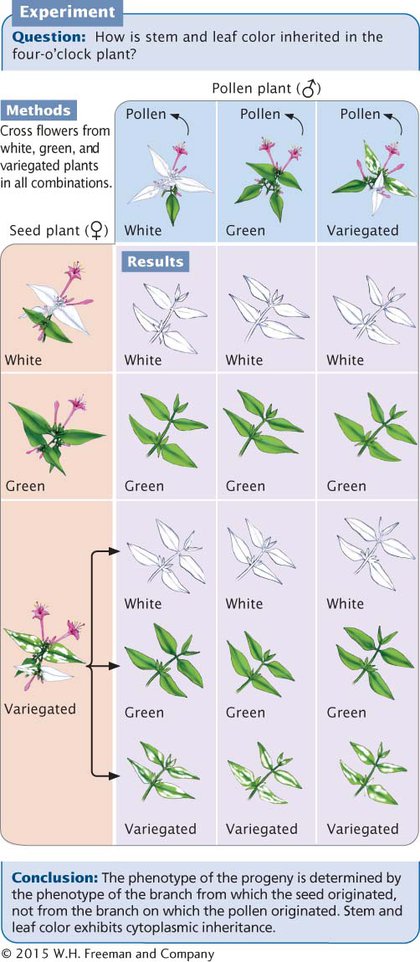Cytoplasmic Inheritance
Mendel’s principles of segregation and independent assortment are based on the assumption that genes are located on chromosomes in the nucleus of the cell. For most genetic characteristics, this assumption is valid, and Mendel’s principles allow us to predict the types of offspring that will be produced in a genetic cross. Not all the genetic material of a cell is found in the nucleus, however. Some characteristics are encoded by genes located in the cytoplasm, and these characteristics exhibit cytoplasmic inheritance.
A few organelles, notably chloroplasts and mitochondria, contain DNA. The human mitochondrial genome contains 16,569 nucleotides of DNA, encoding 37 genes. Compared with the nuclear genome, which contains some 3 billion nucleotides encoding some 20,000 genes, the size of the mitochondrial genome is very small; nevertheless, mitochondrial and chloroplast genes encode some important characteristics.
Cytoplasmic inheritance differs from the inheritance of characteristics encoded by nuclear genes in several important respects. A zygote inherits nuclear genes from both parents, but typically, all its cytoplasmic organelles, and thus all its cytoplasmic genes, come from only one of the gametes, usually the egg. A sperm from the male parent generally contributes only a set of nuclear genes. Thus, most cytoplasmically inherited traits are present in both males and females and are passed from mother to offspring, never from father to offspring. Reciprocal crosses, therefore, give different results when cytoplasmic genes encode a trait. In a few organisms, however, cytoplasmic genes are inherited from the male parent only or from both parents.
Cytoplasmically inherited characteristics frequently exhibit extensive phenotypic variation because no mechanism analogous to mitosis or meiosis ensures that cytoplasmic genes are evenly distributed during cell division. Thus, different cells and different individual offspring will contain various proportions of cytoplasmic genes.
Consider mitochondrial genes. Most cells contain thousands of mitochondria, and each mitochondrion contains from 2 to 10 copies of mitochondrial DNA (mtDNA). Suppose that half of the mitochondria in a cell contain a normal wild-type copy of mtDNA and the other half contain a mutated copy (Figure 4.19). During cell division, the mitochondria segregate into the progeny cells at random. Just by chance, one cell may receive mostly mutated mtDNA and another cell may receive mostly wild-type mtDNA. Therefore, different progeny from the same mother, and even different cells within an individual offspring, may vary in their phenotypes. Traits encoded by chloroplast DNA (cpDNA) are similarly variable. The characteristics that cytoplasmically inherited traits exhibit in pedigrees are summarized in Table 4.6.

4.19 Cytoplasmically inherited characteristics frequently exhibit extensive phenotypic variation because different cells and different individual offspring may contain different proportions of cytoplasmic genes.
TABLE 4.6 Characteristics of cytoplasmically inherited traits
| 1. Present in males and females. |
| 2. Usually inherited from one parent, typically the maternal parent. |
| 3. Reciprocal crosses give different results. |
| 4. Exhibit extensive phenotypic variation, even within a single family. |
Page 100
VARIEGATION IN FOUR-O’CLOCKS In 1909, cytoplasmic inheritance was recognized by Carl Correns as an exception to Mendel’s principles. Correns, one of the biologists who rediscovered Mendel’s work, studied the inheritance of leaf variegation in the four-o’clock plant, Mirabilis jalapa. Correns found that one variety of four-o’clock had leaves and shoots that were variegated, displaying a mixture of green and white splotches. He also noted that some branches of the variegated strain had all-green leaves; other branches had all-white leaves. Each branch produced flowers, so Correns was able to cross flowers from variegated, green, and white branches in all combinations (Figure 4.20). The seeds from green branches always gave rise to green progeny, no matter whether the pollen was from a green, white, or variegated branch. Similarly, flowers on white branches always produced white progeny. Flowers on the variegated branches gave rise to green, white, and variegated progeny in no particular ratio.

4.20 Crosses for leaf type in four-o’clocks illustrate cytoplasmic inheritance.
Correns’s crosses demonstrated the cytoplasmic inheritance of variegation in four-o’clocks. The phenotypes of the offspring were determined entirely by the maternal parent, never by the paternal parent (the source of the pollen). Furthermore, the production of all three phenotypes by flowers on variegated branches is consistent with cytoplasmic inheritance. The white color in these plants is caused by a defective gene in cpDNA, which results in a failure to produce the green pigment chlorophyll. Cells from green branches contain normal chloroplasts only, cells from white branches contain abnormal chloroplasts only, and cells from variegated branches contain a mixture of normal and abnormal chloroplasts. In the flowers from variegated branches, the random segregation of chloroplasts in the course of oogenesis produces some egg cells with normal cpDNA, which develop into green progeny; other egg cells with only abnormal cpDNA, which develop into white progeny; and, finally, still other egg cells with a mixture of normal and abnormal cpDNA, which develop into variegated progeny.
MITOCHONDRIAL DISEASES A number of human diseases (mostly rare) that exhibit cytoplasmic inheritance have been identified. These disorders arise from mutations in mtDNA, most of which occur in genes encoding components of the electron-transport chain, which generates most of the ATP (adenosine triphosphate) in aerobic cellular respiration. One such disease is Leber hereditary optic neuropathy (LHON). Patients who have this disorder experience rapid loss of vision in both eyes, resulting from the death of cells in the optic nerve. This loss of vision typically occurs in early adulthood (usually between the ages of 20 and 24), but it can occur any time after adolescence. There is much clinical variation in the severity of the disease, even within the same family. Leber hereditary optic neuropathy exhibits cytoplasmic inheritance: the trait is always passed from the mother to all children, sons and daughters alike.
Page 101

